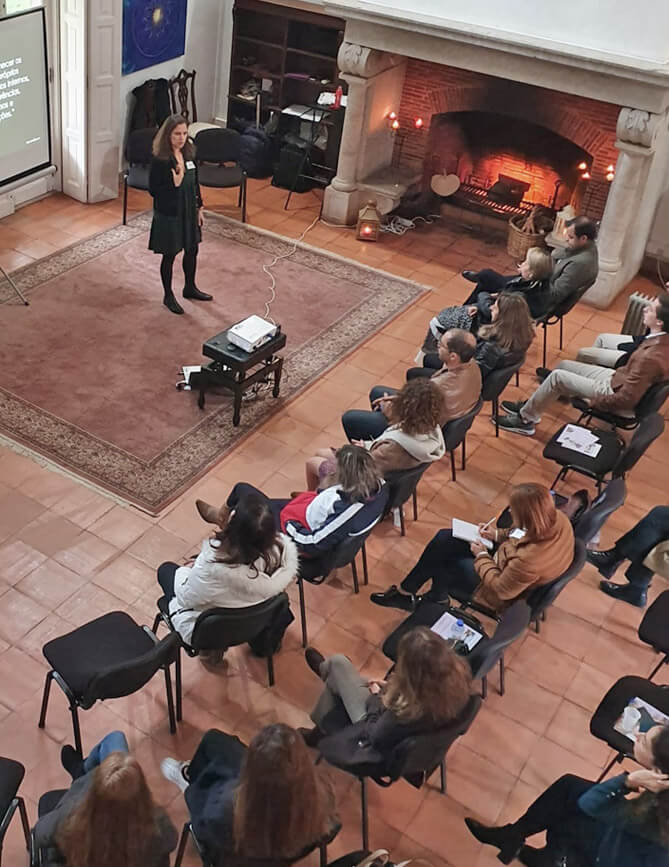In this post, we will explore the first movement of this journey and everything that happens inside to add more clarity to our conceptual framework. You can go deeper in these concepts by reading the previous articles of this series.
The first movement draws and coloring the self. These corresponds to self-perception and self-knowledge.
By “self-perception”, I mean being able to recognize “the five levels of the self” and “the skeleton of the self” inside us. We have gone through them previously. The key thing is to practice in such a way that we can “label” them with easiness.
- seeing clearly the domestic situation that we have, the job that we have, and the people who are in our lives… but bringing into awareness the “roles” we play and how we relate with the means in between: money, technology, and sex. It includes also seeing clearly the “sensorial” information that arrives to us though the five senses: sight, sound, smell, taste, and touch;
- seeing clearly the mind that we have, the inner voice which brings all kind of “thoughts” as they are right now, in this very moment;
- seeing clearly the “emotions” as they feel right now, in this very moment;
- seeing clearly the body and the “sensations” that we have in this very position;
- seeing clearly the energy and the life force that we have in this very place, but bringing into awareness when we “open” or when we “close”;
- seeing clearly how attention wanders, how intention is fuzzy or inherited, and how attitude contributes positively or negatively to our experience.
- seeing clearly how we react to all these things and the impact we create in the form of “suffering” and “conflict”, not trying to make them go away, not trying to change what is there, but just seeing clearly (with calm, precision and gentleness) and open for them, accept what you are seeing without any resistance and embrace them unconditionally.
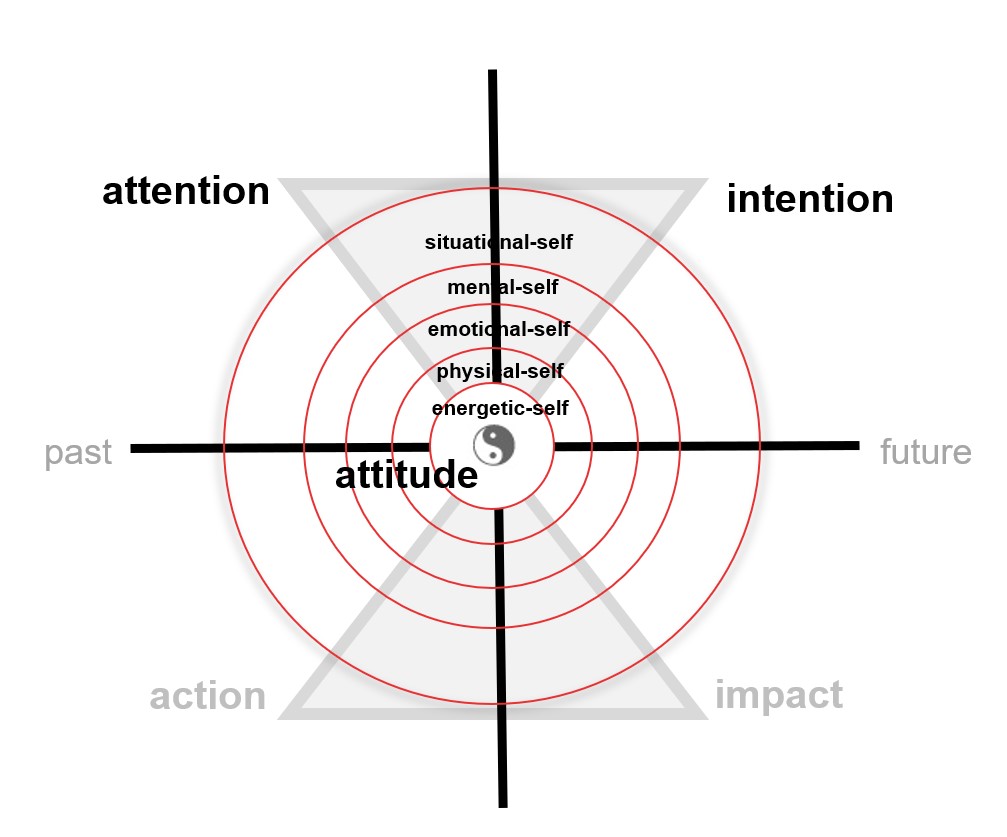
On the other hand, I understand “self-knowledge” as going through three doors:
- self-discovery;
- self-feeling;
- de-identification.
By “self-discovery”, I mean to be able to see clearly where we come from and where we are going, which is another perspective of who we are and what we are doing but focusing on what we remember from our past and what we are anticipating about our future. This movement includes the recognition of what is conscious, what is unconscious, and what feels subconscious.
In this self-discovery, the key-point is “pattern-recognition” and builds on top of the “labeling” (which is the key point in self-perception). We practice finding our true nature. Mindfulness practices like open awareness and body scan are at the center of this phase. Other meditation practices, like vipassana, will also help. In the process, we realize that our experiences in life are the bricks of our neurosis and our wisdom, that our misery contain our wealth, and that our injuries are also the fertile field of our pearls. We practice keeping connected with all elements in you, unrolling experiences as they arrive, getting used to coming back to them regularly, and recognizing the “patterns” in them. We practice embracing the two sides of the coin (our neurosis, shadow, misery, and injuries; and our wisdom, brilliance, wealth, and pearls), recognizing that they are all mix up together, and when together, honoring them as they fully describe our human condition.
- notice the situational-self, that “role” always around that upload almost automatically and sets the stage regarding how you are relating to others and with your own self. Also, how you relate with money, technology, and sex, which fully condition how you relate with others and with your own self. Roles can take very different directions depending on the situation. These are some examples: mum, dad, couple, son, daughter, etc. when in family situations; story-teller, listener, confident, joker, leader, follower, etc. when in friendship situations; or manager, co-worker, problem-solver, leader, etc. when at work situations.
- notice the mental-self, that “thinking” which automatically fills your mind and keeps the inner-voice talking, talking, and talking. Observe that sometimes the voice goes outside, alone or with company. The thought in your mind also takes very different forms and patterns. Examples are beliefs, values, judgements, plans, conversations, etc. They can be rational or creative; they can be original or copied; they can be stream-lined and clear, or amassed and messy. Commonly they are a rumination, like a continuous cycle of things coming once and again to the mind without any clear goal or utility.
- notice the emotional-self, those “feelings” that make you vibe and that automatically arrive to you, softly or abruptly. The basic emotions are six and come in dyads: joy-sadness, rage-fear, and curiosity-disgust. Sometimes, they feel very clear as one basic emotion. Other times, they arrive packed in a little story (which feels like a familiar soundtrack), disguised in a costume that is difficult to understand (like resentment) or entangled like a spaghetti plate (like falling in love). When so, they could feel especially difficult.
- notice the physical-self, especially “sensations” in the inner body and everything that feels inside. The starting point is to keep connected with breathing and getting used to coming back to it. Also observe the basic (survival) feelings: hunger or thirst; urge to urinate or defecate; pain or absence of pain; sick or healthy; rigid or flexible; sexual arousal or neutrality. Notice the patterns that you follow in the forms of habits, routines, and addictions.
- notice the energetic-self, that set of other things inside that we experience as “life force” with temperature and strength. The opposites are well understood: hot or cold; strength or weakness; tense or relaxed; awake or asleep; vitality or sluggishness. Also observe the pattern of “feeling closed” and “feeling open”, although these feelings almost always come paired with any other originated in the rest four levels of the self.
- notice where your intention, attitude, and action are. My preferred approach is to continuously upload the “what?”, “how?” and “why?” questions and let the answers fall without any other will that observing them.
Of course, patterns mostly present themselves as a fuzzy mix of all 5 levels of the self, which adds some adventure to the process. Family stories, lineage seeds, and long-standing traditions are part of the pattern discovery quest. Analytically, we could state that there are mono-self patterns and multi-self patterns. However, the object of discovery is always “what is happening in you at the present moment”. The source data are experiences; the information presents as patterns and impact; and knowledge distills as insights. Colloquially, this could sometimes be referred as “discover your backpack” or “visit your lights and your shadows”. We translate it simply as “finding out what is in the 5 levels of the self that correspond to a distant past or to an imagined future but does not correspond with (what helps the most to) the present moment”. Of course, I will repeat it again, it is key to practice an open attitude full of curiosity, kindness, and no-judgement.
These elements which we want to know, which I think them as “patterns”, are the source of our automatic pilot behavior (automatic role, automatic thinking, and automatic feeling) that keep us stuck in the “same old, same old, same old” reaction over and over again, using Otto Scharmer’s illustrative expression. Also, these elements enact the rigidity in us. Or if we look from the other side, they block our so much needed flexibility in front of life change.
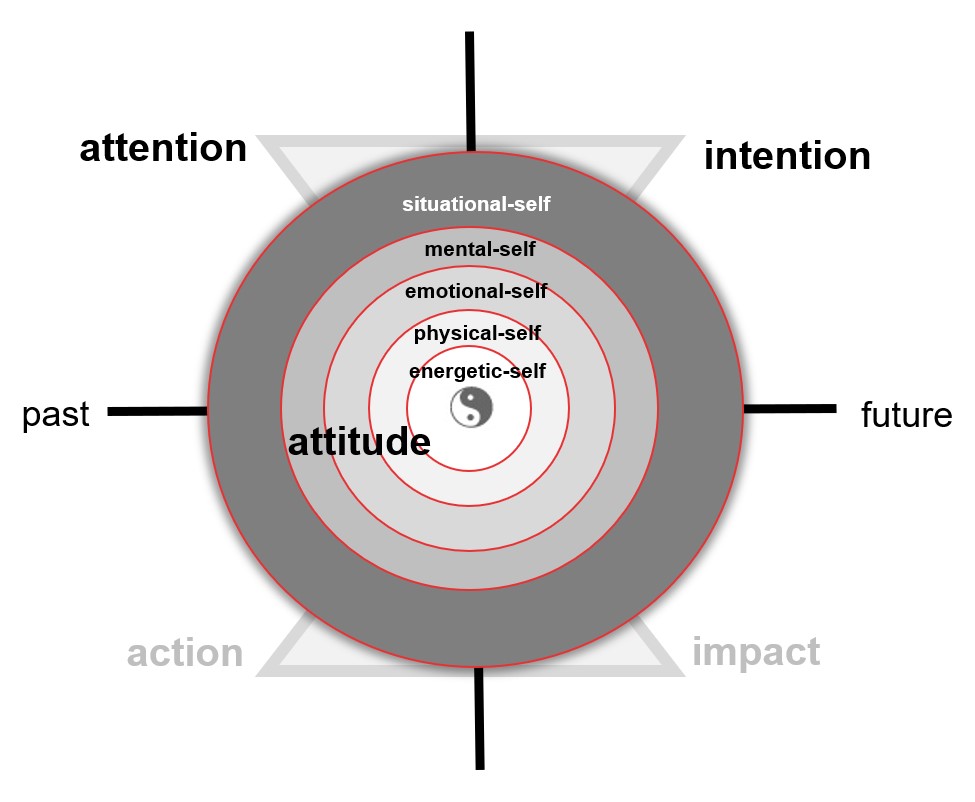
By “self-feeling”, I mean to get used to feel whatever needs to be felt. Self-discovery could look like as an intellectual process. But the mind does not know how to feel. Feelings come from the lower levels of the self. These examples maybe help. The mind will not know what sadness feels until there is sadness. The mind will not know what pain feels until there is pain. The mind will not know what open feels until there is an opening.
So, I like to refer to self-feeling as a different process because all types of soft and strong feelings, coming from the ugly past or the scary future, happen when we observe inside with curiosity. Also, facing our shadow inside will come with deep feelings. If you ever listened about “opening the Pandora’s box”, this is about it. Yuval Noah Harari wisely warns us about the difficulties and limitations of meditation. Some others, like Eckhart Tolle, would refer to this process as recognizing the roles, the ego, and the pain-body in you. Be alert because “trauma” also can arise, so it helps to be attentive and look for the right help. All this intensity is what makes retreats so popular lately; good ones are setup as a safe space guided by helpful, compassionate facilitators.
Mindfulness practices like RAIN, SBNRR, self-compassion, and resilience are at the center of this phase. Any other practice that includes movement of the body will help, like The Fear Melters. In fact, any practice that embraces the “three keys of energy”: movement, sound, and breathing. These practices help on learning to pause and softening the experience of strong feelings. These practices will also bring glimpses of deep presence that can make the experiences more insightful.
This self-feeling movement is about accepting, opening, do not resisting to long-repressed feelings. It is about embracing and self-experiencing our feelings in the present moment. It is about embracing the “colors” of life and getting back in touch with our feelings when they feel great, but especially when they feel not so good or even very difficult.
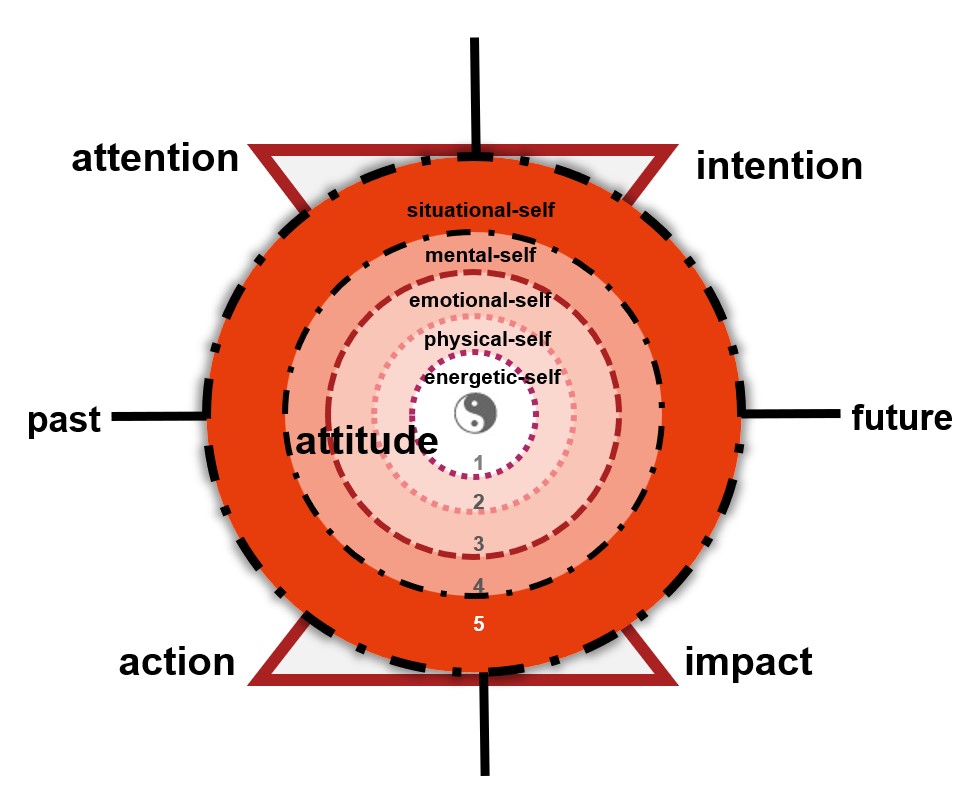
By “de-identification“, I mean breaking identification with the self. It is about getting distance and developing a witness perspective about yourself. You think also as being able to see yourself with the perspective of a neutral but loving third-person. Or moving from a perspective at the center of the map towards a perspective that is borderline of the map. In our framework, it means to add experiential clarity to what looked like a messy “self” before:
- move from situational-self towards having a situational experience;
- move from mental-self towards having a mental experience;
- move from the emotional-self towards having an emotional experience;
- move from the physical-self towards having a physical experience;
- move from the energetic-self towards having an energetic experience;
- move from attention towards meta-attention (which is the attention that is aware of attention itself)
This de-identification can be summarized in a more generic movement: moving from existential to experiential. Instead of getting identified with everything that happens to you, you choose and practice to observe it as an experience that happen to you. So, this is also about choosing and practicing “not to take things personally”. Daniel Kahneman observation about the two selves, the experiencing-self and the remembering-self, will get full meaning for you.
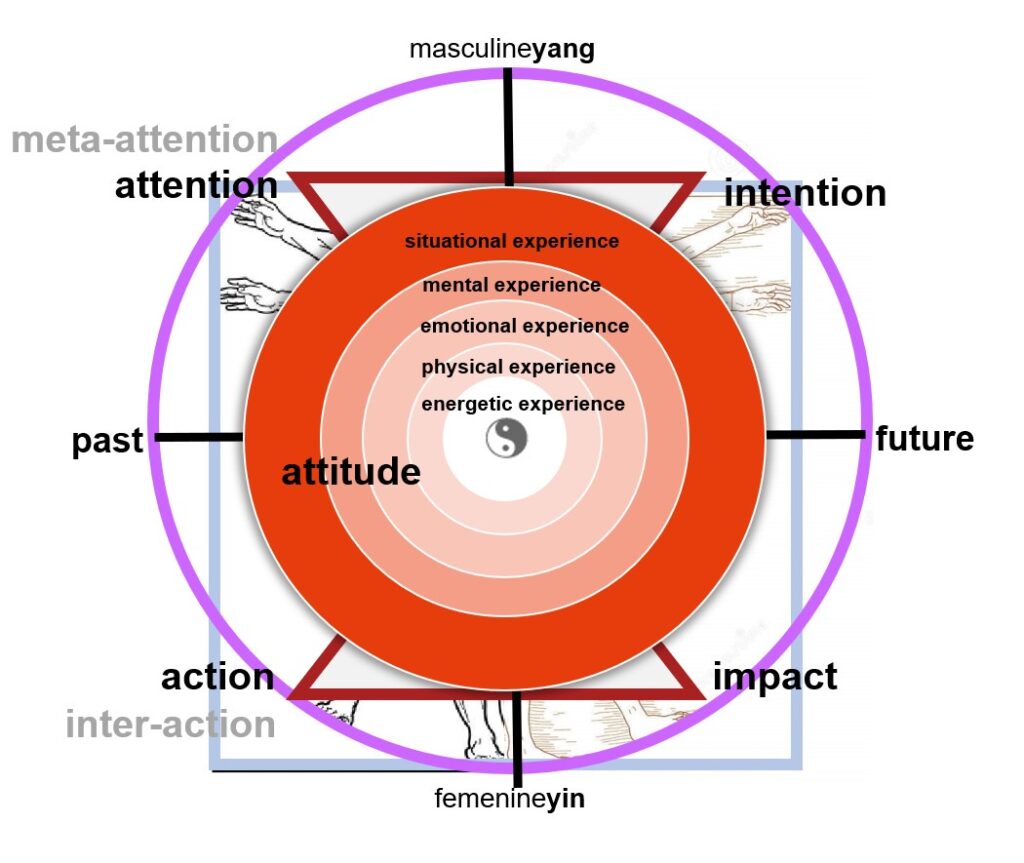
When this movement consolidates, from a safe distance, we recognize with easiness the elements in the self in such a way that we “actually” know ourselves and we are ready to kick-off any self-management. Then, life becomes a stream of experiences that happen to you, and you stay calm while experiencing them with full agency to intervene and create change.
Also, this self-knowledge arrives with a deep intuition that everything inside also happens in others. We intuitively recognize that the richness of the landscape inside comes from our humanness, and we connect with easiness with the common humanity in all of us, in all human beings. Of course, there will be all types of flavors and sizes and colors and genders, but we intuitively know that we all share a basic, common experience. At the same time, we start to recognize that every action is actually an inter-action with the experiences outside.
Just in case it helps, let me finish by adding that journaling deeply helps in all this self-knowledge process. It could be a simple, traditional diary. Or it could be any of the intentional writing practices or trainings around, like “The Self Authoring Suite” proposal by Jordan B. Peterson, or the “Lifebook” proposal by Jon & Missy Butcher. The important thing to consider is that journaling is a key self-knowledge practice.
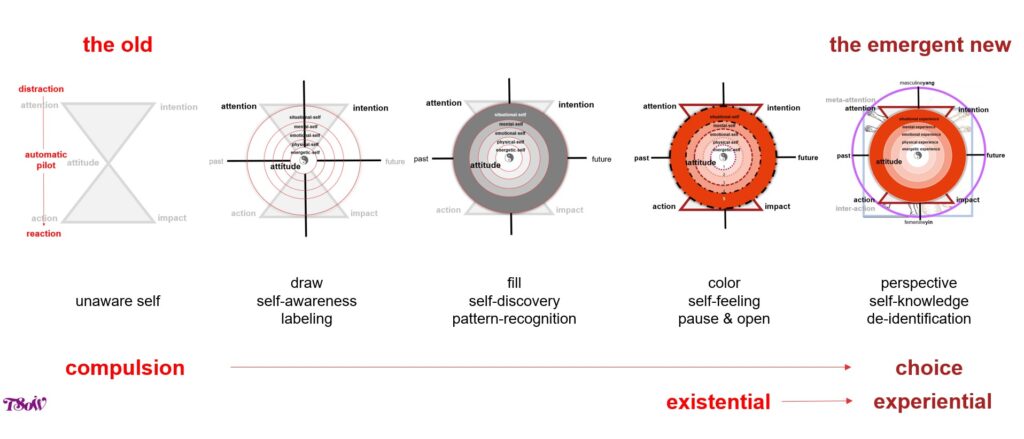
This last image illustrates, one by one, all the drawing, filling, coloring, opening, and de-identification that fully builds self-perception (or self-awareness, if you prefer the more classic wording) and self-knowledge.
This sets the stage for the next movement “M2. Giving order, balance, and quality”. But this will come in the next post of this series. At this point, I hope and wish that this reflection can help you as it helps me in my practice, my teachings, and in my journey.

